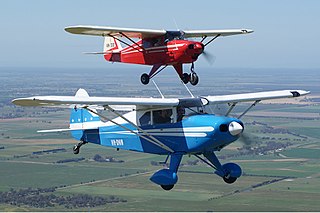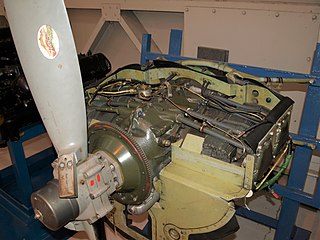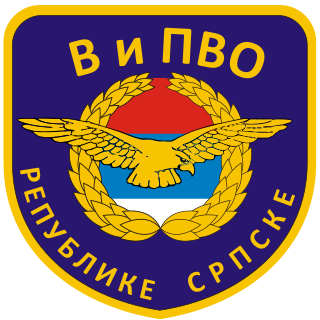
The Cessna O-1 Bird Dog is a liaison and observation aircraft that first flew on December 14, 1949, and entered service in 1950 as the L-19 in the Korean War. It went to serve in many branches of the U.S. Armed Forces, was not retired until the 1970s in a number of variants, and also served in the Vietnam War. It was also called the OE-1 and OE-2 in Navy service, flying with the Marine Corps, and in the 1960s it was re-designated the O-1. It remains a civilian-flown warbird aircraft, and there are examples in aviation museums. It was the first all-metal fixed-wing aircraft ordered for and by the United States Army following the Army Air Forces' separation from it in 1947. The Bird Dog had a lengthy career in the U.S. military as well as in other countries, with over 3400 produced.

The Piper J-3 Cub is an American light aircraft that was built between 1938 and 1947 by Piper Aircraft. The aircraft has a simple, lightweight design which gives it good low-speed handling properties and short-field performance. The Cub is Piper Aircraft's most-produced model, with nearly 20,000 built in the United States. Its simplicity, affordability and popularity invokes comparisons to the Ford Model T automobile.

A bush airplane is a general aviation aircraft used to provide both scheduled and unscheduled passenger and flight services to remote, undeveloped areas, such as the Canadian north or bush, Alaskan tundra, the African bush, or savanna, Amazon rainforest and the Australian Outback. They are used where ground transportation infrastructure is inadequate or does not exist.

The PA-20 Pacer and PA-22 Tri-Pacer, Caribbean, and Colt are an American family of light strut-braced high-wing monoplane aircraft built by Piper Aircraft from 1949 to 1964.

The Piper PA-18 Super Cub is a two-seat, single-engine monoplane. Introduced in 1949 by Piper Aircraft, it was developed from the PA-11 Cub Special, and traces its lineage back through the J-3 Cub to the Taylor E-2 Cub of the 1930s. In close to 40 years of production, over 10,000 were built. Super Cubs are commonly found in roles such as bush flying, banner towing and glider towing.

The Imperial Japanese Army Air Service (IJAAS) or Imperial Japanese Army Air Force was the aviation force of the Imperial Japanese Army (IJA). Just as the IJA in general was modeled mainly on the German Army, the IJAAS initially developed along similar lines to the Imperial German Army Aviation; its primary mission was to provide tactical close air support for ground forces, as well as a limited air interdiction capability. The IJAAS also provided aerial reconnaissance to other branches of the IJA. While the IJAAS engaged in strategic bombing of cities such as Shanghai, Nanjing, Canton, Chongqing, Rangoon, and Mandalay, this was not the primary mission of the IJAAS, and it lacked a heavy bomber force.

The Lycoming O-360 is a family of four-cylinder, direct-drive, horizontally opposed, air-cooled, piston aircraft engines. Engines in the O-360 series produce between 145 and 225 horsepower, with the basic O-360 producing 180 horsepower.

No. 16 Air Observation Post Flight was a Royal Australian Air Force (RAAF) unit that saw action in World War II supporting Australian Army operations. It was formed in October 1944 and disbanded in June 1947. The flight was reestablished in September 1958, and was disbanded again in December 1960, when its responsibilities were transferred to a joint Army-RAAF unit.

The Republika Srpska Air Force was the air force of Republika Srpska and was used primarily during the Bosnian war. In 2005, it was integrated into the Armed Forces of Bosnia and Herzegovina. SFOR still plays a large role in Bosnia and Herzegovina, which consists of the Federation of Bosnia and Herzegovina and Republika Srpska. Under the leadership of one president, the ministry of defense of both entities merged into one single ministry of defense with one chief of joint staff commanding both Air Forces. In 2004 there was again a restructuring of the armed forces, bringing the number of Air Force personnel down to 4,000. Next to the command, the 1st Regiment V i PVO consists out of a platoon, a radar battalion, artillery rocket ADF battalion, AF logistics battalion and aviation assets, a Fighter Bomber Squadron and Mixed Helicopter Squadron. In 2006 the Air Force of Republika Srpska was disbanded.

The Taylorcraft Auster was a British military liaison and observation aircraft produced by the Taylorcraft Aeroplanes (England) Limited company during the Second World War.

The Cameroon Air Force is the air force of Cameroon. The Cameroon Air Force, along with the Cameroon Army, the Cameroon Navy, the National Gendarmerie, and the Presidential Guard make up the Cameroonian Armed Forces.
The Army Light Aviation Unit was the planned aviation unit of the Portuguese Army. Created in 2000 as the Army Light Aviation Group (GALE), it was the Army's unit dedicated to missions of light aviation, being integrated in the Army Forces System, under the operational command of the Ground Forces Operational Command. It was planned to be equipped with light fire support and medium maneuver helicopters. The process of helicopter procurement, however, suffered successive setbacks until being finally canceled in 2012, causing the unit disbandment in 2015.

The 121st Fighter Squadron is a unit of the District of Columbia Air National Guard 113th Wing located at Joint Base Andrews, Camp Springs, Maryland. The 121st is equipped with the Block 30 F-16C/D Fighting Falcon.

The Western Antique Aeroplane and Automobile Museum (WAAAM) is located in Hood River, Oregon, United States, adjacent to the Ken Jernstedt Memorial Airport. WAAAM is a nonprofit 501(c)(3) organization committed to the preservation of, and education about aviation, automobile, and other historic transportation-related relics.

Hattfjelldal Airport is a general aviation airport located in the village of Hattfjelldal, in Hattfjelldal Municipality in Nordland county, Norway. The first simple landing field was constructed in 1933. During World War II it was upgraded by the Luftwaffe to a 930-meter (3,050 ft) concrete runway and it served as a strategic airfield during the occupation of Norway, mostly for a stopovers. The concrete surface built by the Germans is still in use today and is operated by Hattfjelldal Flyklubb. There is no scheduled passenger traffic. The nearest such airports are Hemavan Airport and Mosjøen Airport.

The Air Museum is an aviation museum of the Portuguese Air Force located at Sintra Air Base and with spaces at Ovar and Alverca.

42 Squadron SAAF is a disbanded squadron of the South African Air Force, active from 1945 to 2000. The squadron's main role was to spot enemy artillery. The unit was formed in 1945 as 42 AOP Flight, flying Austers under command of an officer of the SA Artillery and was the only army aviation unit flying for South African forces during World War II.
Massey Air Museum at Massey Aerodrome is an aviation museum near Massey, Maryland, United States.
Kawaguchiko Motor Museum / Fighter Museum is a museum located in Yamanashi prefecture, Japan. Founded in 1981 by former race driver and businessman Nobuo Harada, it has a collection of antique motor vehicles. In 2001 it opened a new area to display a collection of 20th century military aircraft used by Japan, from Japanese Imperial Forces during World War II and the Japan Self-Defense Forces in the postwar period.



















